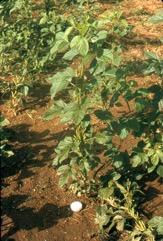Guar bean, Clusterbean

A tropical plant. It is a hardy, drought resistant plant. It suits dry areas. It grows well on alluvial and sandy soils. It grows well in areas with high summer temperatures and low rainfall. It can tolerate an alkaline soil with pH 7.5-8. In Yunnan.
Also known as:
Bakuchi, Bavachi gowar, Dridhabija, Gawar, Goraksha, Gorani, Gorchikuda, Gorikayi, Gowar, Guar, Guwar, Gwaar ki phalli, Jhuppe simi, Kothaveray, Kulti, Kuwara, Pe-pazun, Pe-wali, Phalini
Synonyms
- Cyamopsis psoralioides (Lam.) DC
- Dolichos psoraloides Lam.
- Psoralea tetragonoloba L.
Edible Portion
- Fruit, Leaves, Shoots, Pods, Seeds, Gum, Vegetable
Where does Guar bean grow?
Found in: Afghanistan, Africa, Arabia, Asia, Australia, Central Africa, Chad, China, East Africa, Ethiopia, Fiji, India, Indochina, Indonesia, Kenya, Laos, Malaysia, Mali, Mozambique, Myanmar, Nepal, Pacific, Pakistan, Papua New Guinea, PNG, Philippines, SE Asia, Sierra Leone, Somalia, South Africa, Southern Africa, Sri Lanka, Tanzania, United States, Vietnam, Yemen, West Africa, Zambia
Status: It is a commercially cultivated vegetable. This bean has only been tried in small trial plots in Papua New Guinea.
Growing Guar bean, Clusterbean
Cultivation: They are grown from seed. Often they are grown in mixed cropping situations. It requires 15-24 kg of seed to sow a hectare. Seeds are sown 2-3 cm deep. They are often put 20-30 cm apart in rows 65 cm apart. Seed germinate within one week.
Edible Uses: The green immature pods are eaten cooked. They are added to curries. They can be fried in oil, salted or dried for later use. The seeds are eaten. The seeds contain a gum used as a thickening agent. It is used in ice cream, baked goods, gluten free foods and salad dressing. The sprouted seeds are also eaten.
Production: Plants mature in 3 to 3.5 months.
Nutrition Info
per 100g edible portion| Edible Part | Energy (kcal) | Protein (g) | Iron (mg) | Vitamin A (ug) | Vitamin c (mg) | Zinc (mg) | % Water |
|---|---|---|---|---|---|---|---|
| Fresh Pods | - | 3.7 | 5.8 | 198 | 49 | - | 82 |
| Seeds | 347 | 30.5 | - | - | - | - | 9.9 |
Guar bean, Clusterbean Photos

References
Ambasta, S.P. (Ed.), 2000, The Useful Plants of India. CSIR India. p 152
Arora, R. K., 2014, Diversity in Underutilized Plant Species - An Asia-Pacific Perspective. Bioversity International. p 48, 112
Brouk, B., 1975, Plants Consumed by Man. Academic Press, London. p 262
Burkill, H. M., 1985, The useful plants of west tropical Africa, Vol. 3. Kew.
Burkill, I.H., 1966, A Dictionary of the Economic Products of the Malay Peninsula. Ministry of Agriculture and Cooperatives, Kuala Lumpur, Malaysia. Vol 1 (A-H) p 726 (As Cyamopsis psoralioides)
Cobley, L.S. (rev. Steele, W.M.) 2nd Ed., 1976, An Introduction to the Botany of Tropical Crops. Longmans. p 104
H. G. A. Engler & K. A. E. Prantl, Nat. Pflanzenfam. 3(3):259. 1894
Facciola, S., 1998, Cornucopia 2: a Source Book of Edible Plants. Kampong Publications, p 103
Flora of Pakistan. www.eFloras.org
French, B.R., 1986, Food Plants of Papua New Guinea, A Compendium. Asia Pacific Science Foundation p 52
Grubben, G. J. H. and Denton, O. A. (eds), 2004, Plant Resources of Tropical Africa 2. Vegetables. PROTA, Wageningen, Netherlands. p 560
Hedrick, U.P., 1919, (Ed.), Sturtevant's edible plants of the world. p 254 (As Cyamopsis psoraloides)
ILDIS Legumes of the World http:www:ildis.org/Legume/Web
Jardin, C., 1970, List of Foods Used In Africa, FAO Nutrition Information Document Series No 2.p 73
Kays, S. J., and Dias, J. C. S., 1995, Common Names of Commercially Cultivated Vegetables of the World in 15 languages. Economic Botany, Vol. 49, No. 2, pp. 115-152
Kiple, K.F. & Ornelas, K.C., (eds), 2000, The Cambridge World History of Food. CUP p 1782
Lazarides, M. & Hince, B., 1993, Handbook of Economic Plants of Australia, CSIRO. p 71
Macmillan, H.F. (Revised Barlow, H.S., et al) 1991, Tropical Planting and Gardening. Sixth edition. Malayan Nature Society. Kuala Lumpur. p 323
Pham-Hoang Ho, 1999, An Illustrated Flora of Vietnam. Nha Xuat Ban Tre. p 915
Purseglove, J.W., 1968, Tropical Crops Dicotyledons, Longmans. p 255
Shah, G.L. et al, 1981, An account of the Ethnobotany of Saurashtra in Gujarat State (India). J. Econ. Tax. Bot. Vol 2 pp 173-182
Shah, S. K., 2014, Dietary contribution of underutilized minor crops and indigenous plants collected from uncultivated lands and forests in Nepal. in Promotion of Underutilized Indigenous Food Resources for Food Security and Nutrition in Asia and Pacific. FAO. Bangkok p 64
Sharma, B.B., 2005, Growing fruits and vegetables. Publications Division. Ministry of Information and broadcasting. India. p 148
Smith, A.C., 1985, Flora Vitiensis Nova, Lawaii, Kuai, Hawaii, Volume 3 p 185
Smith, P.M., 1979, Guar, Cluster Bean, in Simmonds, N.W., (ed), Crop Plant Evolution. Longmans. London. p 311
Tindall, H.D., 1983, Vegetables in the Tropics, Macmillan p 263
van Wyk, B., 2005, Food Plants of the World. An illustrated guide. Timber press. p 166
van Wyk, Ben-Erik, 2019, The diversity and multiple uses of southern African legumes. Australian Systematic Botany, 2019, 32, 519–546
World Checklist of Useful Plant Species 2020. Royal Botanic Gardens, Kew